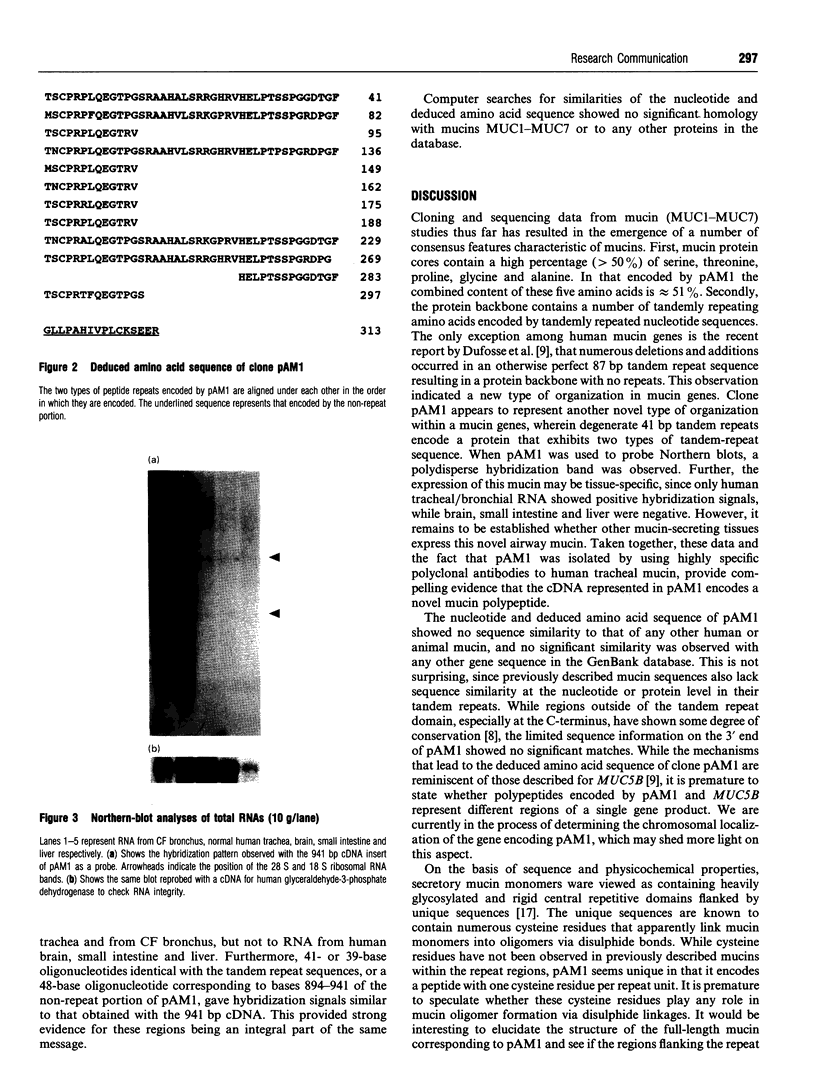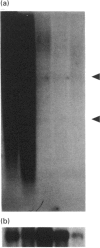Abstract
Highly specific affinity-purified polyclonal antibodies against deglycosylated human tracheobronchial mucin was used to select immunoreactive clones from a Uni-ZAP cDNA expression library prepared from normal human tracheal mRNA. The largest of three positive clones, designated pAM1, which reacted strongly with the polyclonal antibodies, was further characterized. Sequence analyses revealed a partial 941 bp cDNA that encoded a 313-amino-acid polypeptide. Bases 3-892 consisted of imperfect 41-nucleotide tandem repeats (CCAGGAGGGGACACCGGGTTCACGAGCTGCCCACGCCCTCT) that encoded a unique polypeptide with two types of consensus repeats, TSCPRPLQEGTRV and TSCPRPLQEGTPGSRAAHALSRRGHRVHELPTSSPGGDTGF. The overall composition of the deduced amino acid sequence matched that expected for a mucin protein core and is rich in serine, threonine, proline, glycine and alanine (approximately 51%). Northern blots probed with the mucin cDNA exhibited intense polydisperse hybridization bands with RNA isolated from normal human trachea and cystic-fibrosis bronchus. The data indicate that mucin encoded by clone pAM1 represents a unique type of peptide organization which has not been described in mucin cDNAs reported thus far.
Full text
PDF



Images in this article
Selected References
These references are in PubMed. This may not be the complete list of references from this article.
- Bobek L. A., Tsai H., Biesbrock A. R., Levine M. J. Molecular cloning, sequence, and specificity of expression of the gene encoding the low molecular weight human salivary mucin (MUC7). J Biol Chem. 1993 Sep 25;268(27):20563–20569. [PubMed] [Google Scholar]
- Byrd J. C., Lamport D. T., Siddiqui B., Kuan S. F., Erickson R., Itzkowitz S. H., Kim Y. S. Deglycosylation of mucin from LS174T colon cancer cells by hydrogen fluoride treatment. Biochem J. 1989 Jul 15;261(2):617–625. doi: 10.1042/bj2610617. [DOI] [PMC free article] [PubMed] [Google Scholar]
- Crepin M., Porchet N., Aubert J. P., Degand P. Diversity of the peptide moiety of human airway mucins. Biorheology. 1990;27(3-4):471–484. doi: 10.3233/bir-1990-273-426. [DOI] [PubMed] [Google Scholar]
- Desai V. C., Naziruddin B., Graves D. C., Reyes de la Rocha S., Sachdev G. P. Production and characterization of monoclonal antibodies to purified deglycosylated cystic fibrosis respiratory mucin: evidence for the presence of four immunologically distinct epitopes. Hybridoma. 1991 Apr;10(2):285–296. doi: 10.1089/hyb.1991.10.285. [DOI] [PubMed] [Google Scholar]
- Dufosse J., Porchet N., Audie J. P., Guyonnet Duperat V., Laine A., Van-Seuningen I., Marrakchi S., Degand P., Aubert J. P. Degenerate 87-base-pair tandem repeats create hydrophilic/hydrophobic alternating domains in human mucin peptides mapped to 11p15. Biochem J. 1993 Jul 15;293(Pt 2):329–337. doi: 10.1042/bj2930329. [DOI] [PMC free article] [PubMed] [Google Scholar]
- Gendler S. J., Lancaster C. A., Taylor-Papadimitriou J., Duhig T., Peat N., Burchell J., Pemberton L., Lalani E. N., Wilson D. Molecular cloning and expression of human tumor-associated polymorphic epithelial mucin. J Biol Chem. 1990 Sep 5;265(25):15286–15293. [PubMed] [Google Scholar]
- Gendler S., Taylor-Papadimitriou J., Duhig T., Rothbard J., Burchell J. A highly immunogenic region of a human polymorphic epithelial mucin expressed by carcinomas is made up of tandem repeats. J Biol Chem. 1988 Sep 15;263(26):12820–12823. [PubMed] [Google Scholar]
- Gum J. R., Byrd J. C., Hicks J. W., Toribara N. W., Lamport D. T., Kim Y. S. Molecular cloning of human intestinal mucin cDNAs. Sequence analysis and evidence for genetic polymorphism. J Biol Chem. 1989 Apr 15;264(11):6480–6487. [PubMed] [Google Scholar]
- Gum J. R., Hicks J. W., Swallow D. M., Lagace R. L., Byrd J. C., Lamport D. T., Siddiki B., Kim Y. S. Molecular cloning of cDNAs derived from a novel human intestinal mucin gene. Biochem Biophys Res Commun. 1990 Aug 31;171(1):407–415. doi: 10.1016/0006-291x(90)91408-k. [DOI] [PubMed] [Google Scholar]
- Gum J. R., Jr, Hicks J. W., Toribara N. W., Rothe E. M., Lagace R. E., Kim Y. S. The human MUC2 intestinal mucin has cysteine-rich subdomains located both upstream and downstream of its central repetitive region. J Biol Chem. 1992 Oct 25;267(30):21375–21383. [PubMed] [Google Scholar]
- Gum J. R., Jr Mucin genes and the proteins they encode: structure, diversity, and regulation. Am J Respir Cell Mol Biol. 1992 Dec;7(6):557–564. doi: 10.1165/ajrcmb/7.6.557. [DOI] [PubMed] [Google Scholar]
- Padhye N. V., Naziruddin B., Desai V. C., Reyes de la Rocha S., Sachdev G. P. Physicochemical characterization of a minor mucin component from cystic fibrosis tracheobronchial secretions. Biochim Biophys Acta. 1991 Apr 29;1077(3):332–338. doi: 10.1016/0167-4838(91)90548-e. [DOI] [PubMed] [Google Scholar]
- Porchet N., Nguyen V. C., Dufosse J., Audie J. P., Guyonnet-Duperat V., Gross M. S., Denis C., Degand P., Bernheim A., Aubert J. P. Molecular cloning and chromosomal localization of a novel human tracheo-bronchial mucin cDNA containing tandemly repeated sequences of 48 base pairs. Biochem Biophys Res Commun. 1991 Mar 15;175(2):414–422. doi: 10.1016/0006-291x(91)91580-6. [DOI] [PubMed] [Google Scholar]
- Shankar V., Naziruddin B., Reyes de la Rocha S., Sachdev G. P. Evidence of hydrophobic domains in human respiratory mucins. Effect of sodium chloride on hydrophobic binding properties. Biochemistry. 1990 Jun 19;29(24):5856–5864. doi: 10.1021/bi00476a030. [DOI] [PubMed] [Google Scholar]
- Toribara N. W., Roberton A. M., Ho S. B., Kuo W. L., Gum E., Hicks J. W., Gum J. R., Jr, Byrd J. C., Siddiki B., Kim Y. S. Human gastric mucin. Identification of a unique species by expression cloning. J Biol Chem. 1993 Mar 15;268(8):5879–5885. [PubMed] [Google Scholar]
- Vaitukaitis J. L. Production of antisera with small doses of immunogen: multiple intradermal injections. Methods Enzymol. 1981;73(Pt B):46–52. doi: 10.1016/0076-6879(81)73055-6. [DOI] [PubMed] [Google Scholar]



